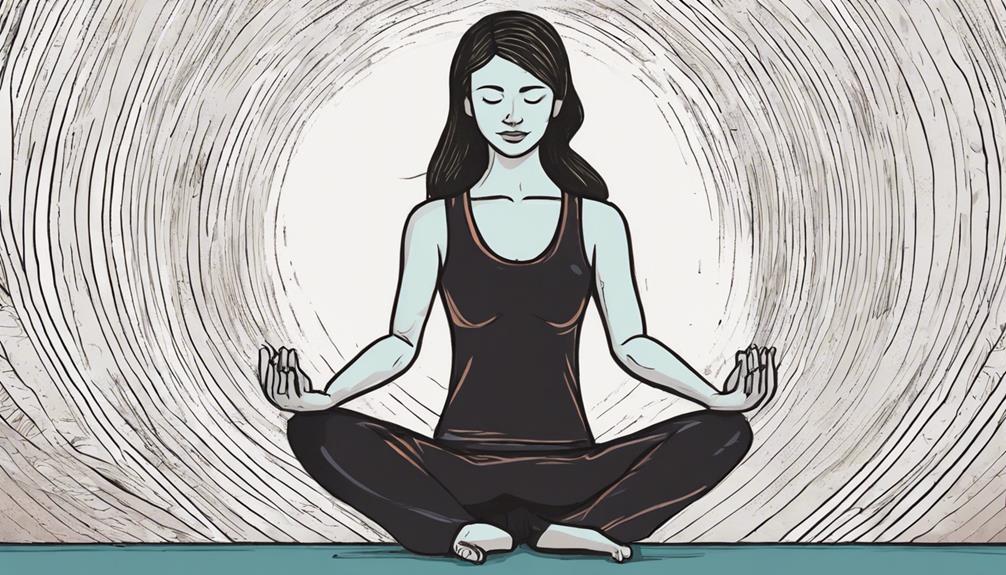Yes, yoga can be a form of somatic therapy as it combines somatics and yoga practices for holistic healing. It focuses on releasing tension and addressing trauma by integrating somatic awareness with yoga postures and breathing techniques. This gentle yet powerful method helps work through trauma, anxiety, and chronic pain by creating a safe space for reconnecting with your body and emotions. Exploring the integration of somatics and yoga in somatic therapy offers a unique approach to healing and holistic well-being.
Key Takeaways
- Yoga Somatic Therapy combines somatics and yoga for holistic healing.
- Focuses on releasing tension, addressing trauma, and enhancing body awareness.
- Integrates somatic awareness, yoga postures, breath work, and meditation.
- Supports trauma healing, improves mental health, and empowers self-regulation.
- Enhances mind-body connection, reduces stress, and promotes emotional resilience.
Understanding Somatic Yoga Therapy

In understanding Somatic Yoga Therapy, practitioners integrate somatics and yoga practices for holistic healing. This therapeutic approach explores the interconnectedness of the body and mind, focusing on releasing tension, promoting self-awareness, and addressing trauma.
By combining somatic awareness with yoga postures and breathing techniques, individuals can investigate their internal sensations and movement patterns to cultivate a deeper understanding of their bodies.
Somatic yoga therapy offers a gentle yet powerful method for individuals to work through trauma, anxiety, and chronic pain. Through intentional movements, breathwork, and mindfulness practices, practitioners can create a safe space to reconnect with their bodies and emotions.
Benefits of Somatic Yoga Practices

By incorporating somatic yoga practices into your routine, you can experience a range of benefits that promote relaxation and enhance your overall well-being. Somatic yoga helps release tension and tightness in the body, leading to relaxation and reduced stress levels. Through these practices, you develop a deeper body awareness, allowing you to better understand and care for your physical self. The mind-body connection is strengthened through somatic yoga, fostering harmony and a sense of wholeness. By tuning into your internal sensations during somatic yoga sessions, you can release accumulated stress and tension that may be stored in your muscles, promoting a sense of lightness and ease.
Engaging in somatic yoga practices, such as Flow Dance Meditation, can further aid in releasing emotional tensions and supporting holistic healing. These practices offer a holistic approach to well-being, addressing physical, mental, and emotional aspects of health to promote overall wellness and energy.
Somatic Yoga Approach and Practice

When practicing somatic yoga, you'll explore core somatic principles and techniques that focus on internal bodily sensations.
By engaging in slow, mindful movements, you can deepen your mind-body connection and release muscular tension effectively.
Somatic yoga offers a holistic approach to wellness through internal sensation tuning.
Core Somatic Principles
Exploring core somatic principles in somatic yoga involves integrating mindful movements to enhance body-mind connection and promote relaxation. Somatic therapy within yoga focuses on trauma healing through gentle movements that prioritize body-mind integration.
By engaging in somatic practices, individuals can release tension, heighten body awareness, and induce a sense of calm. Somatic yoga encourages connecting with internal sensations to alleviate muscular tightness and stress, facilitating a deeper understanding of one's physical and emotional well-being.
Through movement re-education, somatic yoga aids in enhancing mobility, strength, and posture by rewiring the brain-body connection. Common practices like spinal release and moving meditations are frequently incorporated into somatic yoga classes to assist in muscle re-education and promote a holistic approach to well-being.
Somatic Yoga Techniques
Somatic yoga techniques emphasize the integration of body and mind through mindful movements and breath awareness, fostering a deeper connection to your physical and emotional well-being. In Somatic Yoga, the focus is on body-mind integration, with practitioners engaging in deliberate movements aimed at re-educating muscles and releasing tension. Classes typically incorporate somatic exercises, yoga postures, breath work, and meditation practices to enhance mindfulness and awareness of the body's sensations. Through this practice, individuals can become more attuned to their bodies, emotions, and triggers, leading to a heightened sense of self-awareness.
One of the significant benefits of Somatic Yoga is its support for trauma healing. By reconnecting the mind and body, this approach aids in integrating past traumas and fostering a more profound sense of inner peace. The trauma-sensitive nature of Somatic Yoga provides a safe space for individuals to explore their bodies and emotions, promoting healing and growth.
Transformation Through Somatic Yoga

Embark on a journey of self-discovery and personal growth through the transformative practice of somatic yoga. Somatic yoga courses delve into the intricate connection between the mind and body, offering individuals a pathway to explore subtle sensations and release trauma responses stored in the body. This transformative practice, often facilitated by somatic therapists, encourages individuals to engage deeply with themselves, revealing hidden emotions and promoting healing. By immersing oneself in somatic yoga, you can begin to understand how the body keeps the score of past experiences and how these experiences manifest in your physical and emotional well-being.
To gain a deeper insight into the transformational journey of somatic yoga, let's explore how this practice can lead to personal growth and self-exploration:
| Transformation Through Somatic Yoga | ||
|---|---|---|
| 1. Expands body's experience | 2. Fosters self-exploration | 3. Encourages deep engagement |
| 4. Draws individuals repeatedly | 5. Leads to poetic experience |
Exploring Somatics in Yoga

Engage with the transformative power of somatic yoga by exploring the integration of body and mind through internal exploration. The somatic approach in yoga emphasizes the interconnectedness of body and mind, inviting you to go beyond physical postures and delve into your internal sensations.
Here are three key aspects to ponder when exploring somatics in your yoga practice:
- Body-Mind Integration: Somatic cues in yoga encourage you to synchronize your physical movements with your mental awareness, fostering a deeper connection between your body and mind.
- Internal Exploration: Through somatic yoga practices, you have the opportunity to explore your body from within, paying attention to how different movements and sensations affect your overall well-being.
- Somatic Cues in Yoga: By prioritizing comfort, personal choice, and support during your practice, somatic yoga helps you notice and transform any harmful movement patterns, empowering you to become an active participant in your own physical and mental health journey.
Somatic Therapy for Healing Trauma

Explore how somatic therapy offers a holistic approach to healing trauma by addressing the mind-body connection and supporting individuals in processing and releasing stored traumatic experiences.
Trauma healing through somatic therapy involves recognizing that trauma isn't only stored in the mind but also in the body. Emotions associated with traumatic experiences can manifest physically, leading to emotional dysregulation and physical symptoms. Developmental Trauma, which stems from early life experiences, can particularly benefit from somatic therapy techniques such as Movement Therapy.
Somatic Experiencing therapy, pioneered by Dr. Peter Levine, is one such body-centered practice that helps individuals regulate their nervous system and work through past traumas. By incorporating movement, breathwork, and body awareness, somatic therapy aims to release tension and promote healing from traumatic experiences.
This approach acknowledges the interconnectedness of the body and mind, offering a safe space for individuals to process their trauma and find relief from the lasting effects of past experiences.
Yoga as Therapy for Trauma

Yoga can be a powerful tool in healing from trauma, helping you process stored emotions and alleviate PTSD symptoms.
By attuning to your body through trauma-sensitive yoga, you can reconnect with your emotions and foster peace within yourself.
This therapeutic approach focuses on reuniting your mind and body, offering a pathway to healing and restoring balance in your mental health and relationships.
Trauma and Yoga
Trauma-sensitive yoga serves as a therapeutic modality that aids individuals in re-establishing the disrupted mind-body connection caused by trauma.
Here are three key points to keep in mind:
- Reducing Dissociation: Studies have shown that trauma-sensitive yoga programs can effectively reduce symptoms of dissociation in participants. This indicates the potential of yoga in helping individuals ground themselves and stay present in their bodies.
- Processing Trauma: Somatic yoga offers a unique approach to processing trauma stored in the body. Unlike traditional talk therapies, somatic practices address the physical aspect of trauma, providing a valuable tool for individuals seeking healing.
- Trauma Integration: By supporting individuals in reconnecting with their emotions and bodies, somatic yoga aids in trauma integration and healing. This approach acknowledges the interconnectedness of the mind and body, allowing for a thorough healing experience.
Healing Through Yoga
Healing from trauma through yoga involves reconnecting your mind and body to facilitate the processing of stored trauma in a somatic way. Somatic yoga and trauma-sensitive yoga techniques focus on integrating your emotions with your body, allowing you to address and release past traumas. By engaging in somatic practices, you can attune to your body's sensations, reconnect with suppressed emotions, and work towards finding peace within yourself.
Research indicates that trauma-sensitive yoga can be particularly beneficial in reducing symptoms of PTSD and aiding in the healing process. Through somatic yoga, individuals can embrace uncomfortable feelings, break free from recurring trauma cycles, and promote body-mind integration.
Grounding exercises and self-regulatory practices embedded in somatic yoga play an essential role in enhancing overall wellbeing and restoring balance to your life. By engaging in these healing practices, you can start on a journey towards greater self-awareness and emotional resilience.
Somatic Therapy Benefits
Reconnecting your mind and body through somatic therapy can offer profound benefits for those seeking healing from trauma. Somatic yoga, a form of somatic therapy, focuses on integrating physical sensations, emotions, and thoughts to address trauma stored in the body.
Here are three key benefits of somatic therapy for trauma healing:
- Improved Mental Health: Somatic yoga helps individuals process and release trauma, reducing symptoms of PTSD and anxiety. By fostering a mind-body connection, this therapeutic approach can enhance emotional regulation and overall mental well-being.
- Grounding Exercises: Somatic yoga includes grounding exercises that promote a sense of safety and stability. These practices help individuals feel more present and connected to the present moment, reducing feelings of dissociation often associated with trauma.
- Self-Regulatory Practices: Engaging in self-regulatory practices within somatic yoga empowers individuals to regulate their nervous system responses. By learning to self-soothe and manage stress, individuals can cultivate resilience and coping skills for dealing with the effects of trauma.
Frequently Asked Questions
Is Yoga Considered Somatic Therapy?
Yes, yoga is considered somatic therapy as it focuses on the mind-body connection and embodiment. Through exploring sensations and movements, yoga aligns with somatic therapy principles, enhancing body awareness, releasing tension, and promoting overall well-being.
Does Somatic Yoga Actually Work?
Does somatic yoga actually work? It does! Studies show it reduces PTSD and anxiety symptoms. Reconnect with your body, release tension, and promote mindfulness. Through movement, breathwork, and mindfulness, support healing and well-being.
How Is Somatic Yoga Different From Yoga?
In somatic yoga, you focus on internal body sensations and movements, re-educating brain-muscle connection through deliberate movements. It integrates mindfulness, somatic movement, and yoga postures for healing, releasing tension and enhancing well-being.
Can You Teach Yourself Somatic Therapy?
You can teach yourself somatic therapy, but consider expert guidance for deeper insights. Online resources and workshops offer a start, yet occasional sessions with a professional can elevate your practice and healing journey.
Conclusion
So, after immersing yourself in the world of somatic yoga therapy, you now understand the powerful connection between mind, body, and spirit.
The benefits of this practice are truly life-changing, offering a unique approach to healing and transformation. With somatic yoga, you can tap into your inner strength and resilience like never before.
It's not just a workout, it's a profound journey of self-discovery and healing. Immerse yourself and experience the transformative power of somatic yoga for yourself!









